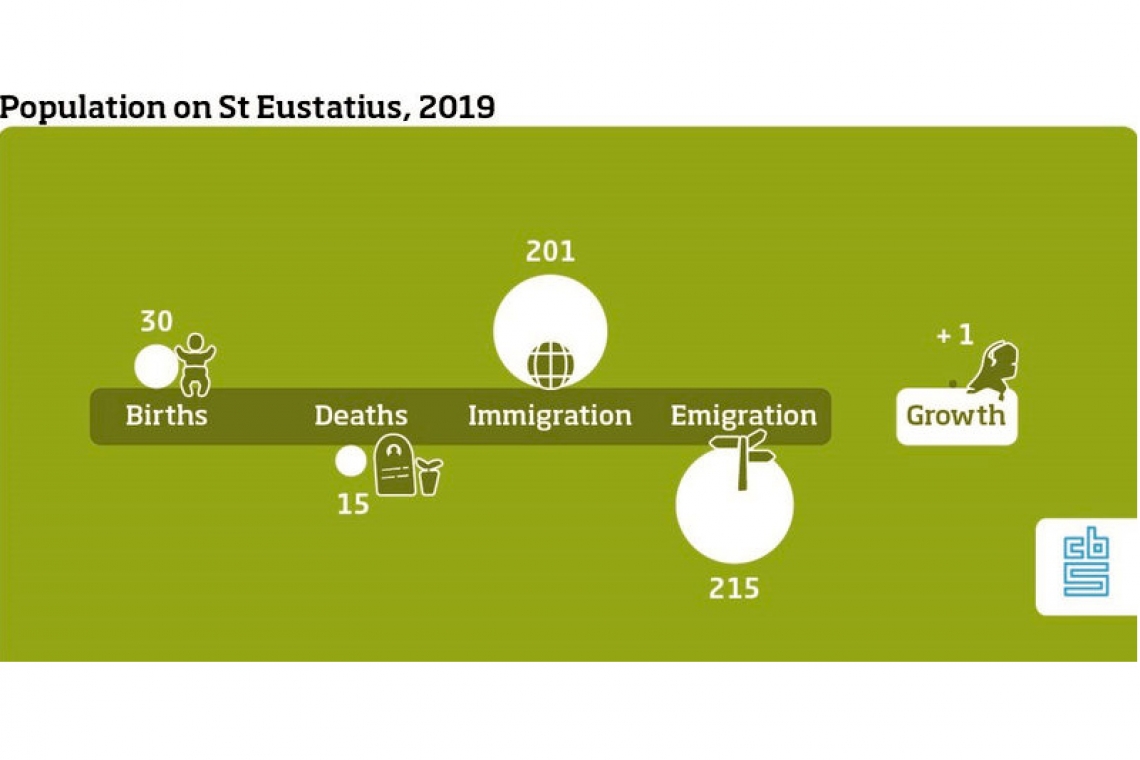CBS infographics
SABA/ST. EUSTATIUS--The population of the Caribbean Netherlands stood at nearly 26,000 on January 1, 2020, which constitutes a growth by 830 persons compared with 2019. This increase is almost entirely on account of Bonaire, as the populations in Saba and St. Eustatius hardly grew, or did not grow at all.
 On balance, more people settled in the Caribbean Netherlands than left the islands. Natural growth played a modest role in the population increase, Central Bureau for Statistics (CBS) reported Tuesday based on the most recent population figures for Bonaire, Statia and Saba.
On balance, more people settled in the Caribbean Netherlands than left the islands. Natural growth played a modest role in the population increase, Central Bureau for Statistics (CBS) reported Tuesday based on the most recent population figures for Bonaire, Statia and Saba.
At 3,100, the number of inhabitants in Statia on January 1, 2020, was virtually the same as one year previously. The balance of births and deaths was slightly positive (30 versus 15). Net migration was negative, as 201 immigrants settled in Statia, while 215 emigrants left the island last year.
On balance, more people came to Statia from the Dominican Republic and Colombia than vice versa. The same held true for the European Netherlands.
By contrast, in 2018 more people moved from Statia to the Netherlands on balance. This was due to a clean-up of Statia’s civil register at the time, which caused a downward adjustment of the number of inhabitants. There was no such clean-up in 2019, the CBS said.
The CBS also called it noteworthy that the number of persons who moved to another address in Statia almost doubled last year. This was also related to the civil registry’s clean-up operations which resulted in a number of address corrections and an improved population register, the CBS stated.
Saba had 1,900 inhabitants early 2020, which is 18 persons or almost one per cent more than in 2019. With 11 live births and 13 deaths, natural population growth was negative in Saba.
The small population growth was on account of a positive migration balance of 20 persons, primarily due to slightly more people from the United States and the Dominican Republic settling in Saba. Conversely, migration from Saba to the European Netherlands was higher than vice versa, the CBS stated.
There was a decline in the number of Saba residents in 2018 due to a clean-up of the population register. During this process, persons who were still registered but in reality had already left the island were removed from the civil registry. In 2018, this led to a decline in the number of US and Canadian nationals registered in Saba. There was no such clean-up in 2019, the CBS said.
Bonaire counted 20,900 inhabitants on January 1, 2020. This is an increase of 811 persons (or four per cent) relative to one year previously. Most (87 per cent) of this growth can be attributed to positive net migration, as more people migrated to Bonaire (nearly 1,500) than left the island (770).
The balance of births and deaths amounted to 106 (203 live births minus 97 deaths), contributing 13 per cent to the island’s population increase, the CBS said.
On balance, the majority of migrants were from Curaçao, followed at a great distance by the Dominican Republic, Venezuela, Peru, the European Netherlands and the United States.
The number of people trading Curaçao for Bonaire was considerably higher in 2019 than in the previous year. There were also more people from the Dominican Republic arriving on the island.
On the other hand, migration from Venezuela declined, the CBS stated. As of early 2019, it is no longer possible to move directly from Venezuela to Bonaire.
More people left Bonaire for the European Netherlands than vice versa in 2018. However, in 2019 more people moved from the European Netherlands to Bonaire.







